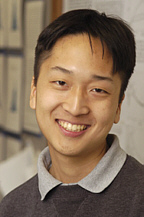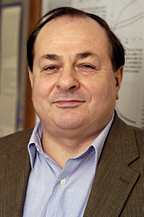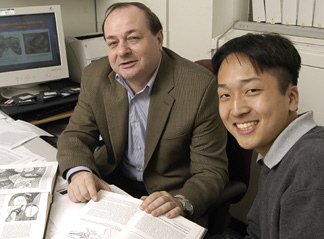
News Release
|
Office of News and Information Johns Hopkins University 901 South Bond Street, Suite 540 Baltimore, Maryland 21231 Phone: 443-287-9960 | Fax: 443-287-9898 |
March 10, 2004 FOR IMMEDIATE RELEASE CONTACT: Phil Sneiderman prs@jhu.edu |
Crucial for Hearing
Computer Models Could Help Explain How
Cochlear Outer Hair Clusters Boost Sounds
A 21-year-old Johns Hopkins undergraduate is playing an important role in solving the mysteries surrounding tiny hair cells in the inner ear that help humans distinguish between high-frequency sounds, an ability that is critical for understanding speech. The work could lead to a better understanding of age-related hearing loss and to the improvement of hearing aids.
 William Hsu (pictured at right), a senior from
Westlake Village, Calif., has been working on the ear cell
research under the supervision of a Johns Hopkins faculty
member since his sophomore year. Last fall, the biomedical engineering
major used a Provost's Undergraduate Research Award grant
from the university to devote more time to the project,
with the goal of publishing results in a peer-reviewed
journal.
William Hsu (pictured at right), a senior from
Westlake Village, Calif., has been working on the ear cell
research under the supervision of a Johns Hopkins faculty
member since his sophomore year. Last fall, the biomedical engineering
major used a Provost's Undergraduate Research Award grant
from the university to devote more time to the project,
with the goal of publishing results in a peer-reviewed
journal.
"William's educational path here was related to his research," said Alexander Spector, his faculty sponsor and an associate research professor in the Department of Biomedical Engineering. "I encouraged him to take classes relevant to this research. He's become more and more involved in the project, and now he has his own piece of it. I plan to submit his work to a scientific journal by the time of his graduation."
 Spector (pictured at left) directs a team of
students who have been studying the outer hair cells of the
cochlea, a snail-shaped, fluid-filled structure within the
inner ear. Sounds waves vibrate through the cochlear fluid
and excite clusters of hair cells in the surrounding
membrane. Inner hair cells pick up sounds and turn them
into electrical signals that zip across nerve fibers to the
brain. Mammals, including humans, also possess outer hair
cells, whose purpose puzzled researchers for many years
because these cells cannot send sound messages to the
brain. In 1985, however, scientists learned that outer hair
cells in the lab changed their length when subjected to an
electric field. When these hair cells are within the
cochlear membrane, this size-changing characteristic is
believed to give them the ability to amplify certain sounds
before the sounds are transmitted to the brain.
Spector (pictured at left) directs a team of
students who have been studying the outer hair cells of the
cochlea, a snail-shaped, fluid-filled structure within the
inner ear. Sounds waves vibrate through the cochlear fluid
and excite clusters of hair cells in the surrounding
membrane. Inner hair cells pick up sounds and turn them
into electrical signals that zip across nerve fibers to the
brain. Mammals, including humans, also possess outer hair
cells, whose purpose puzzled researchers for many years
because these cells cannot send sound messages to the
brain. In 1985, however, scientists learned that outer hair
cells in the lab changed their length when subjected to an
electric field. When these hair cells are within the
cochlear membrane, this size-changing characteristic is
believed to give them the ability to amplify certain sounds
before the sounds are transmitted to the brain.
"These outer hair cells help us discriminate different frequencies, and that's critical in understanding human speech," Hsu said. "But these hair cells are delicate. As we age, they can deteriorate and become less sensitive, leading to hearing loss."
 PHOTOS BY HPS/WILL KIRK |
To address this problem, researchers need a better understanding of how outer hair cells do their work. Spector's team has been trying to solve some of the mysteries surrounding why the electrical activity of these cells seems to behave differently in the lab than within living tissue. As part of this project, Spector assigned Hsu to create mathematical models of the ionic channels in the outer hair cell membrane. These microscopic gatekeepers allow ions to move in or out of cells, changing the cell's overall electric potential. By varying the parameters of the computer model, Hsu is trying to find the combination that will resolve the cell's electrical activity paradox.
"Working with Dr. Spector has given me different perspective on research," Hsu said. "When I came to Hopkins, I thought research involved sitting behind a lab bench, working with chemicals. I didn't know that research could involve creating computer models. I've learned that we can do experiments with them. We can play around with our models and see how well they predict what happens in the actual cells."
After graduating in May, Hsu hopes to continue his education in a biomedical engineering doctoral program.
On Thursday, March 11, Steven Knapp, university provost and senior vice president for academic affairs, will host the 11th annual Provost's Undergraduate Research Awards ceremony, which will honor the 41 winners who conducted their projects in the summer and fall of 2003. Since 1993, about 40 students each year have received PURA grants of up to $3,000 to conduct original research, some results of which have been published in professional journals. The awards, funded through a donation from the Hodson Trust, are an important part of the university's commitment to research opportunities for undergraduates.
The Johns Hopkins University is recognized as the country's first graduate research university, and has been in recent years the leader among the nation's research universities in winning federal research and development grants. The opportunity to be involved in important research is one of the distinguishing characteristics of an undergraduate education at Johns Hopkins.
The Provost's Undergraduate Research Awards program provides one of these research opportunities, open to students in each of the university's four schools with full-time undergraduates: the Krieger School of Arts and Sciences, the Whiting School of Engineering, the Peabody Conservatory and the School of Nursing.
Color photos of the researchers available; Contact Phil Sneiderman.
Related Links
Alexander Spector's Web Page
Johns Hopkins Department of Biomedical
Engineering
|
Johns Hopkins University news releases can be found on the
World Wide Web at
http://www.jhu.edu/news_info/news/ Information on automatic e-mail delivery of science and medical news releases is available at the same address.
|
 Go to
Headlines@HopkinsHome Page
Go to
Headlines@HopkinsHome Page